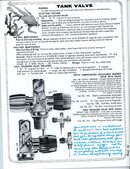If you use those valves, you really need to replace those burst discs. If I remember correctly from my PSI/PCI class, the word “illegal” was used. And that is because they are fairly dangerous if/when they fail due to pressure being released in a single direction. Modern burst discs direct the air in 3 opposing/cancelling directions, imparting minimal motion to the cylinder.
I would expect a high likelihood that any shop paying attention will not fill a cylinder with such a valve. The hazard is more on them at time of fill than on you.
Yes, when my 1970-ish USD cylinder was refilled in 2009 after a 30 year hiatus and successful hydro, the old single direction burst disk blew and caused the cylinder to dance around the room, knocking a hole in the plaster. Fortunately, the corroded disk blew at a fairly low pressure. Tom Huff, the shop owner, kindly replaced the valve with a rebuilt Genesis K-valve at no cost (thereby winning a loyal customer for many years).




